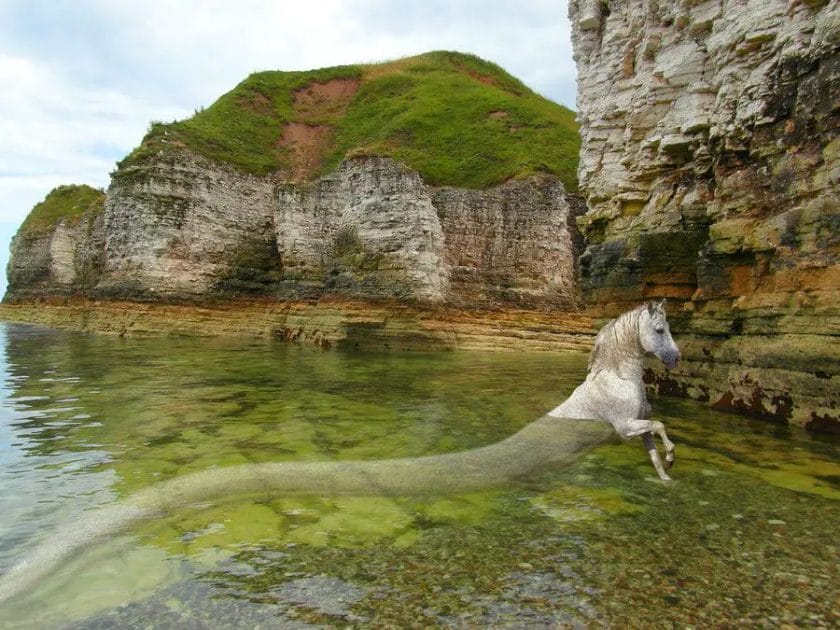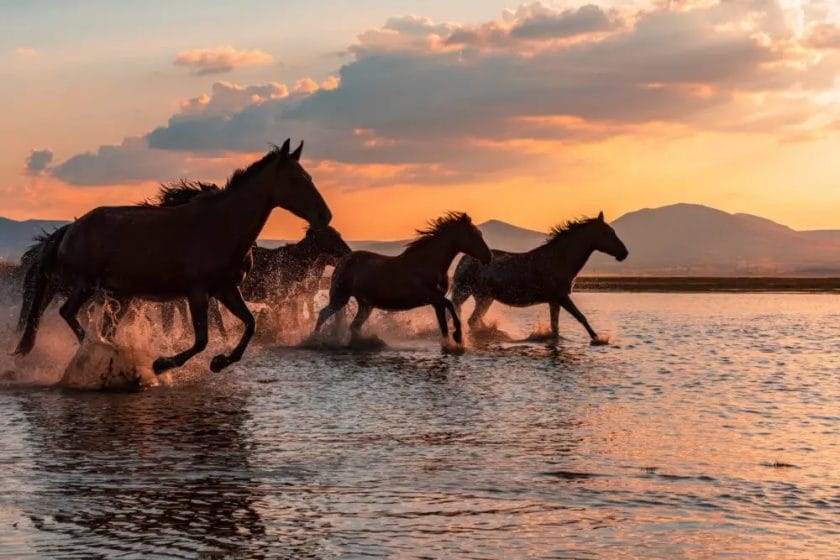Water horses, also known as kelpies or each-uisge, are mythical creatures that originate from Scottish folklore.
Believed to dwell in lochs and rivers, these supernatural beings are said to be shape-shifters who take the form of horses to lure humans into the water.
Legends describe them as powerful and beautiful, but also dangerous and malicious, as they often drag unsuspecting victims to a watery demise.
While water horses may not exist in the physical realm, they continue to captivate imaginations and inspire stories of enchantment and cautionary tales.

Legends and Folklore Surrounding Water Horses
Water horses, also known as kelpies or each-uisge, are mythical creatures that have been a source of fascination and fear in various cultures around the world. These majestic creatures are said to inhabit bodies of water such as lakes, rivers, and seas, and are often depicted as powerful and malevolent beings.
One of the most famous legends surrounding water horses originates from Scottish folklore. According to the legend, kelpies are shape-shifting creatures that often take the form of beautiful horses to lure unsuspecting victims. These victims, once mounted on the back of the kelpie, become trapped and are carried into the depths of the water, never to be seen again.
In some versions of the legend, the kelpie’s skin is said to be adhesive, making it impossible for anyone who touches it to let go. This adds to the danger and allure of the creature, as people are enticed to touch the beautiful horse only to become ensnared and dragged into the water.
Legends and folklore surrounding water horses are not limited to Scotland. Similar stories can be found in other parts of the world, such as Ireland and Iceland. In Irish folklore, the water horse is known as the each-uisge, and is said to be a shapeshifting creature that takes the form of a horse or a handsome young man. It is said that once touched by a human, the each-uisge becomes impossible to control and will gallop into the nearest body of water, drowning its rider.
In Iceland, the water horse is known as the nykur. Unlike the Scottish kelpie and the Irish each-uisge, the nykur is often described as a gentle and helpful creature. It is said to assist farmers by carrying heavy loads and helping with farm work. However, if mistreated or disrespected, the nykur can turn vengeful and cause harm to humans.
Legends and folklore surrounding water horses often serve as cautionary tales, warning people of the dangers that lurk in bodies of water. These stories reinforce the belief that one should be cautious and respectful when near lakes, rivers, and seas, as these mythical creatures may be waiting to ensnare and drag unsuspecting victims into their watery domains.
The Role of Water Horses in Popular Culture
The legends and folklore surrounding water horses have not only captivated the imaginations of people throughout history, but have also influenced popular culture in various forms of media. These mythical creatures have made appearances in literature, art, and even movies.
In literature, water horses have been featured in numerous fantasy novels and folklore collections. They serve as intriguing and mysterious characters, enhancing the sense of danger and adventure in these stories. Authors often weave the legends and folklore associated with water horses into their narratives, adding depth and richness to their fictional worlds.
Water horses have also been a popular subject in art. Paintings and sculptures depicting these mystical creatures can be found in museums and galleries around the world. These artworks capture the beauty, power, and allure of water horses, showcasing the connection between mythology and artistic expression.
Furthermore, water horses have made appearances in movies and television shows, further cementing their place in popular culture. From animated films to live-action adaptations, these creatures continue to captivate audiences with their enigmatic nature and mythical origins.
In summary, legends and folklore surrounding water horses have played a significant role in shaping cultural narratives and captivating the human imagination. From cautionary tales to works of art, these mythical creatures continue to fascinate and intrigue people around the world.

Characteristics and Abilities of Water Horses
Water horses, also known as hippocampi, are mythical creatures that have captivated human imaginations for centuries. These majestic beings are often depicted as a hybrid between a horse and a fish, with the upper body of a horse and the lower body of a fish, complete with fins and a tail. In folklore and mythology, water horses are believed to possess a range of unique characteristics and abilities that set them apart from ordinary horses.
1. Aquatic Adaptations
One of the most notable features of water horses is their ability to thrive in aquatic environments. With their fish-like tails and webbed feet, they are well-equipped for swimming and navigating underwater. The streamlined body of a water horse allows it to move effortlessly through the water, making them incredibly agile swimmers.
2. Communication through Singing
Water horses are known for their enchanting songs that echo through the depths of the ocean. These melodious tunes are said to have a mesmerizing effect on those who hear them, often luring sailors and sea creatures alike with their alluring melodies. It is believed that water horses use their songs to communicate with other members of their species and to establish their territories.
3. Exceptional Speed and Endurance
Water horses possess incredible speed and endurance both in and out of the water. When galloping on land, they can reach astonishing speeds, rivaling those of the swiftest land-dwelling horses. In the water, their streamlined bodies allow them to move with grace and speed, effortlessly navigating the currents and waves.
4. Magical Healing Abilities
Legend has it that the touch of a water horse has magical healing properties. Their gentle touch is said to have the power to cure ailments and injuries, making them revered creatures in folklore. According to ancient tales, individuals who are fortunate enough to encounter a water horse and receive their healing touch are blessed with renewed health and vitality.
5. Guardians of the Sea
Water horses are often depicted as guardians of the sea, protecting its creatures and maintaining the balance of the underwater realm. They are seen as symbols of wisdom, strength, and grace, embodying the harmonious relationship between land and sea. In folklore, it is believed that water horses guide lost sailors to safety and offer protection to those in need.
6. Shapeshifting Abilities
Water horses possess the remarkable ability to shapeshift, allowing them to assume different forms depending on their surroundings and the situation at hand. This innate power gives them the advantage of blending in with their surroundings, making them elusive and mysterious creatures. It is said that some water horses can even take on the appearance of humans, further adding to their mystique.
7. Connection to Ancient Mythology
Water horses have deep roots in ancient mythology and folklore, with references to these creatures appearing in various cultures around the world. In Greek mythology, hippocampi were often depicted as the mounts of sea gods and goddesses. In Celtic folklore, they were believed to be magical creatures that brought forth storms and represented the untamed power of the sea.
In summary, water horses are extraordinary beings with a range of fascinating characteristics and abilities. From their aquatic adaptations and mesmerizing songs to their exceptional speed and healing touch, these mythical creatures continue to capture the imagination and awe of people across different cultures.

Encounters and Sightings of Water Horses in History
Throughout history, there have been numerous accounts of encounters and sightings of water horses, mythical creatures that are said to inhabit bodies of water such as lakes, rivers, and seas. Known by different names in different cultures, water horses have been a part of folklore and legends for centuries. Here, we explore some of the most notable encounters and sightings of these mystical creatures.
1. The Kelpie of Scotland
One of the most famous water horses is the Kelpie, a creature from Scottish mythology. The Kelpie is often described as a shape-shifting creature that appears as a beautiful horse or a human-like figure near bodies of water, luring unsuspecting individuals to their doom. It is said to have a supernatural strength and the ability to breathe fire. Several stories depict encounters with the Kelpie, with brave individuals managing to escape its clutches.
2. The Each-uisge of Ireland
In Irish folklore, the Each-uisge is a water horse that is believed to live in rivers and lakes. Similar to the Kelpie, it is known to have the ability to shape-shift into a beautiful horse, luring people to ride on its back. Once mounted, the Each-uisge would gallop into the water, trapping its victims underwater until they drown. There have been accounts of encounters with the Each-uisge, often cautionary tales warning people to stay away from bodies of water.
3. The Nykur of Iceland
Icelandic folklore tells of a creature called the Nykur, which is a water horse known for its enticing appearance. The Nykur is said to have the ability to change its size and shape, appearing as a friendly horse to lure people closer. Once someone mounts the Nykur, it rushes into the water, dragging its victim beneath the surface. Stories of encounters with the Nykur have been shared for generations, serving as warnings to those who venture too close to the water’s edge.
4. The Bai Ze of Chinese Mythology
While not specifically a water horse, the Bai Ze from Chinese mythology is a creature with the head of a horse and the body of a lion. It possesses great wisdom and knowledge, being able to speak and provide information. According to legends, the Bai Ze emerged from the water and presented Emperor Yao with a book containing knowledge of all creatures. Although not as menacing as other water horses, the Bai Ze holds its own place in mythology.
5. Modern Sightings and Pop Culture
While many sightings of water horses are rooted in folklore and legends, there have been modern reports of encounters with these creatures as well. Some individuals claim to have seen mysterious horse-like creatures in bodies of water, describing their encounters with awe and fear. These sightings often find their way into local legends and add to the allure of these mythical beings.
Additionally, water horses have made appearances in popular culture, further perpetuating the fascination with these creatures. They have been featured in books, movies, and artworks, captivating audiences with their mystical and sometimes dangerous nature.
Summary
Encounters and sightings of water horses throughout history have captivated the imaginations of people across cultures. These mythical creatures, such as the Kelpie, Each-uisge, Nykur, and the Bai Ze, have left their mark in folklore and legends. While some stories serve as cautionary tales, others highlight the allure and mystery surrounding these majestic creatures. Whether believed to be shape-shifting tricksters or wise beings, water horses continue to intrigue and inspire curiosity in the minds of those who venture near bodies of water.
Conservation Efforts to Protect Water Horse Habitats
Water horses are magnificent creatures that inhabit various bodies of water, including lakes, rivers, and oceans. However, due to human activities and environmental issues, their habitats are under threat. In order to protect these unique species and maintain a healthy ecosystem, conservation efforts are being implemented around the world.
1. Protected Areas and Reserves:
One of the most significant conservation efforts is the establishment of protected areas and reserves specifically designated for water horse habitats. These areas act as safe havens for these creatures, providing them with the necessary protection from human interference and habitat destruction. By designating these areas, governments and environmental organizations aim to preserve the natural environment and biodiversity of water horse habitats.
2. Restoration of Aquatic Ecosystems:
Conservation efforts also focus on restoring and enhancing aquatic ecosystems that serve as crucial habitats for water horses. This includes projects such as removing invasive species, restoring wetlands, and implementing measures to improve water quality. By restoring these ecosystems, the overall health and productivity of the habitat are improved, benefiting the water horses along with other aquatic species.
3. Education and Awareness:
Raising awareness about the importance of water horse habitats and their conservation is key to ensuring their survival. Educational programs, workshops, and campaigns are organized to educate the public, local communities, and policymakers about the value of these habitats. By promoting a greater understanding and appreciation for water horses, people are more likely to support conservation efforts and take action to protect their habitats.
4. Collaboration and Partnerships:
Conservation efforts often involve collaboration between various stakeholders, including governments, NGOs, local communities, and scientists. By working together, these groups can pool their resources, knowledge, and expertise to develop effective conservation strategies. Partnerships with local communities are particularly important, as they often have valuable traditional knowledge and can actively participate in monitoring and protecting water horse habitats.
5. Research and Monitoring:
Ongoing research and monitoring play a crucial role in conservation efforts for water horse habitats. By studying the behavior, population dynamics, and ecological interactions of water horses, scientists can better understand their needs and develop targeted conservation plans. Monitoring programs also help assess the effectiveness of conservation measures and identify any emerging threats to the habitats, allowing for timely action to be taken.
In summary, conservation efforts to protect water horse habitats are essential for the survival of these magnificent creatures. Through the establishment of protected areas, restoration of aquatic ecosystems, education and awareness programs, collaboration and partnerships, and ongoing research and monitoring, we can ensure the long-term viability of water horse populations and the preservation of their habitats for generations to come.
FAQs
Are water horses real?
No, water horses are mythical creatures that exist only in folklore and mythology. They are often portrayed as supernatural creatures that have the ability to live and move in water. However, there is no scientific evidence to support the existence of water horses in the real world.
Conclusion
In conclusion, the existence of water horses remains a subject of myth and folklore. While there have been tales and legends throughout history describing these mystical creatures, no concrete scientific evidence has been found to support their actual existence.
However, the concept of water horses continues to capture the imagination and fascination of many. From Celtic legends to modern-day movies and literature, the allure of these enigmatic creatures persists.
Whether or not water horses are real, their presence in folklore serves as a reminder of humanity’s enduring connection to the mysteries of the natural world.
